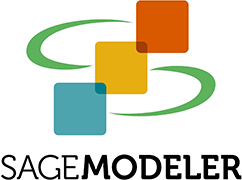SageModeler makes it possible for students to create their own computational models. It takes a systems approach to modeling phenomena, so it also provides opportunities for engaging students in systems thinking and learning about modeling in general.
Using SageModeler in your classes generally takes two forms:
- As a standalone modeling tool
- Embedded within curricular units authored by the SageModeler team or partner projects using SageModeler
SageModeler used as a standalone modeling tool in your own curriculum
SageModeler can easily be launched using the “Launch SageModeler” button.
Once launched students can create models, save them locally to their device or to Google Drive, and share them with their peers and teachers.
For teachers who use an LMS like Google Classroom or Moodle, a common pattern is to assign the link https://sagemodeler.concord.org/app and ask students to respond to that assignment by turning in a share link to their model. If you would like students to start with a pre-authored model that you created, you could assign your own share link rather than the link to launch the app with a blank canvas.
Curricular unit authored by the SageModeler team or partner projects
We are still in the early stages of refining curricular units and researching the best methods for creating lesson sequences as well as supporting students and teachers in using SageModeler most effectively. However, some of the units have been made public, including an Introduction to Modeling Unit, which has an extensive teacher guide.
The units that are currently available can be found in the Building Models Collection on the Concord Consortium’s STEM Resource Finder.
To see the teacher guides:
- Create a free teacher account.
- Login.
- Scroll down the Building Models collection page to find the SageModeler Curriculum Units.
- Expand the section, and click on one of the units to see additional details, including a link to a teacher guide and a way to assign it to classes.
Note: Help on using the STEM Resource Finder for assigning materials, collecting student data, and generating reports can be found using the Help link from the “My Classes” page when you are logged in.
